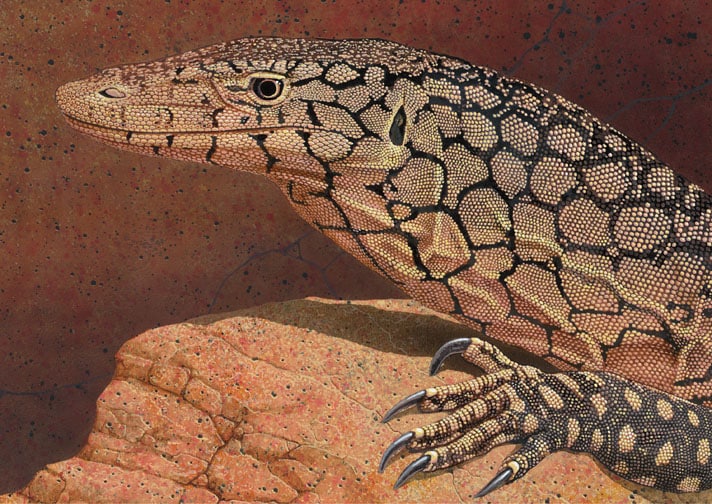Wildlife artist Tell Hicks discusses his work, his life, and a horrifying moment involving a kid with a paint brush full of white paint.
If you’ve been to a reptile expo in the past bunch of years, chances are you’ve seen Tell Hicks’ fantastic reptile artwork, whether it was some of his very impressive original paintings or the wide variety of terrific t-shirt and hat designs that are sold by Ecowear Publishing. You may have even seen Tell, as the man himself has often been on display while working on a new painting.
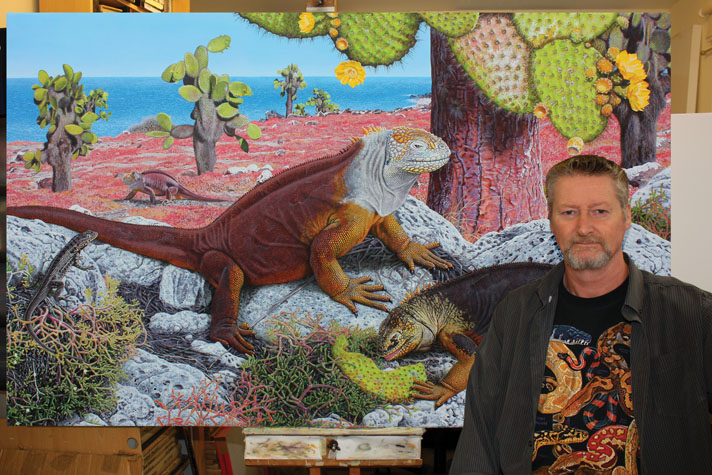
Courtesy tell hicks
The Galapagos Islands are an all-time favorite source of inspiration for Tell’s paintings, including this one of the land iguanas there.
With his reptile artwork so prevalent, I thought it was about time REPTILES had a chat with Tell Hicks about his art, and himself.
REPTILES: Tell us about yourself—your early days, training/schooling as an artist, etc. Were there other artists who inspired you, then and now?
Tell Hicks: I can’t remember a time when I didn’t want to be an artist. As a really young child I would fill sketchbooks with paintings of animals and people. I can recall building up a collection of portraits of neighborhood dogs and pets.
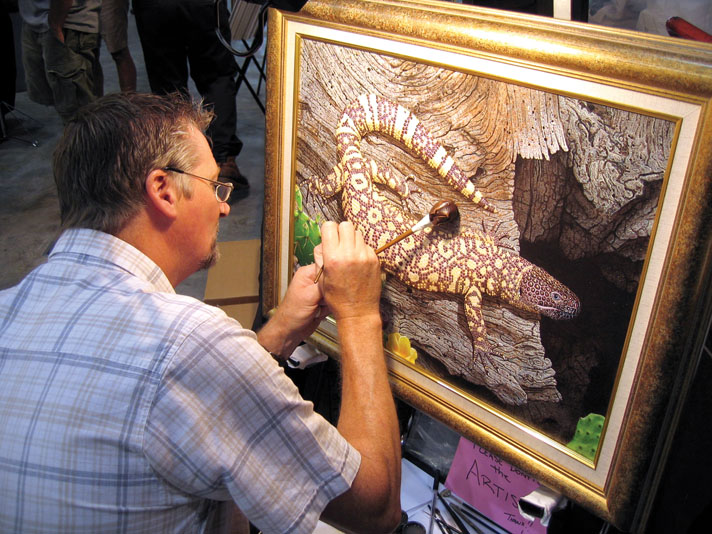
courtesy tell hicks
Tell working on a Gila monster painting at a show in 2006.
At school, it was always my paintings that adorned the classroom walls. I had no doubt, even then, that I would be an artist, and that passion has stayed with me throughout my life.
At the age of 9 I was given the book, Prehistoric Animals, illustrated by Zdenek Burian, an artist whose work inspires me still. His paintings were so imaginative and exciting. The early wildlife programs by naturalist David Attenborough were also a huge inspiration for me, as were the portfolios of paintings produced by traveling artists/naturalists such as Audubon and Gould.
At the age of 17, instead of going to college, my lust for travel and adventure led me away from home and school. At 19, with about $300 in my pocket, I set off across Europe and Asia, through Iran, Afghanistan and India, hitchhiking, camping rough, and catching and sketching reptiles and wildlife along the way. I eventually arrived, penniless, in Australia.
REPTILES: Have you always been interested in herps? Do you have any favorite types?
Tell Hicks: I’ve always kept animals and been fascinated by them. My parents got used to me turning up with orphaned baby birds, fox cubs and other animals. Any injured wildlife found in the neighborhood usually ended up at our house.
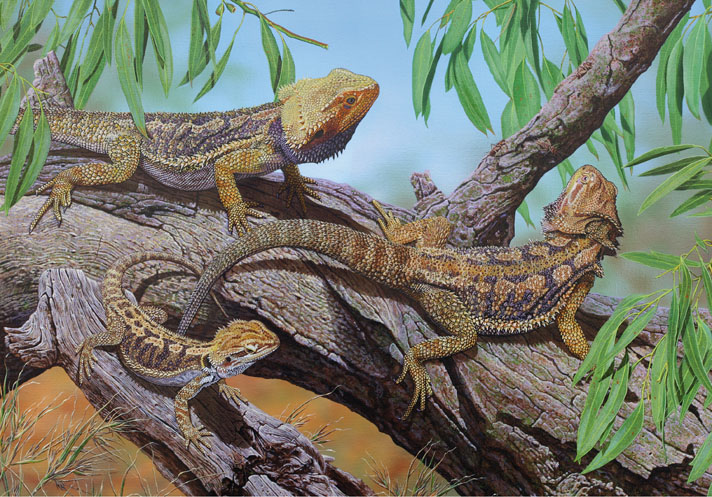
Courtesy Tell Hicks
Bearded dragons.
When I was 10 years old, my family moved to Buckinghamshire and I discovered a colony of European adders near our house. I would spend every spare moment watching and sketching them. On one such occasion I had a chance meeting with snake expert Tony Phelps. Tony became a close friend and mentor, and for many years we traveled around the UK, studying the native herpetofauna and promoting its conservation. It was Tony who encouraged me into zoo work, and I can look back with very fond memories of the times we spent messing around with crocs, cobras and other exotic species. It was a great start for a young man destined to become a herpetological artist.
I still keep a few reptiles. In recent years I’ve concentrated on keeping and breeding both eastern and western fox snakes, but I have to confess that European vipers continue to be my favorite snakes.
REPTILES: What is your preferred type of media?
Tell Hicks: As a self-taught artist, I’ve experimented over the years with various mediums. For several years I developed some new techniques in egg tempera, an ancient method of painting using egg yolk to bind the pigments. It’s a tricky medium, requiring a lot of discipline in its preparation and application, but I loved both the process and the results.
These days I use Alkyd Oil Paints, a fast-drying and very permanent oil paint. They have allowed me to continue using the techniques I developed with egg tempera, and are perfect for when I’m painting at the shows and need to pack away a”dry”painting at the end of the day.
I still produce t-shirts and cap designs for Bob and Sheri Ashley at Eco. The process that I employ for creating the shirts is basically the same as when I used to do the individual screen print separations, by hand, with ink, on sheets of film. Nowadays I use more modern technology and create the separations and cap designs digitally. They still take quite a long time to produce, though.
REPTILES: You’re well known among reptile people for your herp paintings; do you also paint other types of wildlife?
Tell Hicks: Reptiles are a real passion, and I’ve tended to specialize in them, but I consider myself to be a bit of an all-round naturalist. Over the years I’ve painted plenty of non-reptile subjects, and several of my most recent projects have been of mammals and birds. I also enjoy painting human portraits.
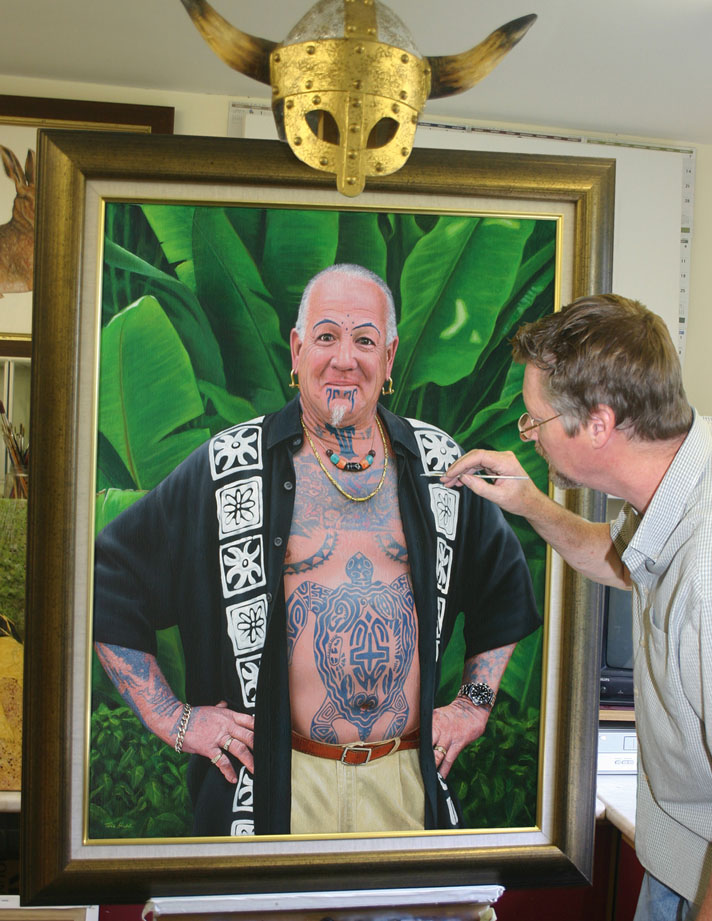
courtesy tell hicks
While he’s known for his reptile paintings, Tell Hicks also enjoys painting portraits, such as this one of "Tattoo Pete" Gardiner.
When I’m away on a herping trip I’m constantly looking for interesting plants to photograph. There’s always a chance that I can include them in some future composition. I enjoy painting them and, when you need to pay attention to detail, it’s so important to have the appropriate species of plant, even if it’s just in the background.
REPTILES: What is a typical day like for you when you’re working on a painting?
Tell Hicks: Fellow artists often joke about how productive I am. It’s true that I’ve accrued quite a catalog of work, but it’s not because I’m a fast painter. My painting technique of building up layers of thin paint is frustratingly slow, and such detailed work can be pretty time consuming.
I’m usually in the studio by 9 am, and apart from breaks for meals, coffee and checks on my fox snakes and turtles, I’m in the studio working until 9 pm. If there is a particular deadline to be met, I’ll occasionally work later, but my wife Eileen quite rightly insists that I take some time off to keep her company.
REPTILES: Were there any watershed moments or events that led you to where you are today, in regard to getting your work out to the public? How did you come to meet Bob and Sheri Ashley?
Tell Hicks: As most aspiring artists will tell you, it’s a difficult profession in which to succeed. Being a parent and having a mortgage to pay has meant that I’ve had to be flexible and get other jobs from time to time, just to pay the bills. I’ve been lucky to have such an understanding wife in Eileen, who has tolerated me giving up some very well paid, secure, employment for the uncertainty of an artistic career.
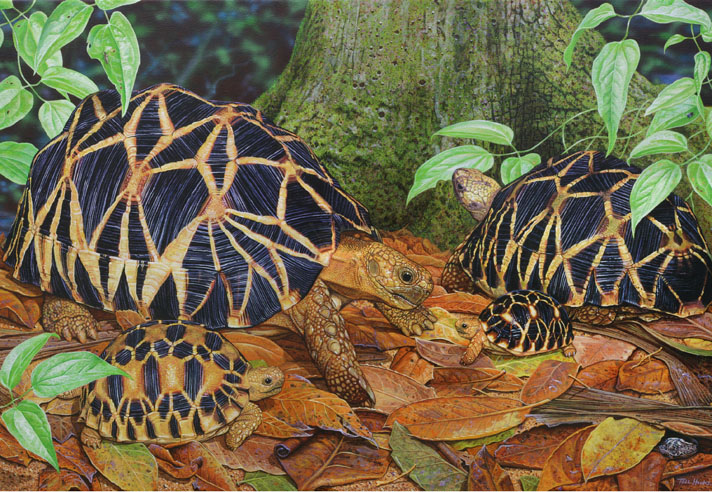
Courtesy Tell Hicks
Burmese star tortoises.
I’ve been asked to produce work for several publishing companies over the years, but chose to self-publish my own prints, instead. It’s given me more control over their subject matter but, on the downside, has required plenty of financial investment and lots of extra work to produce and promote them.
I first met Bob Ashley at the Reptile Breeders Expo in Orlando, Fla., many years ago. Our friendship very quickly developed into a strong professional relationship, and my artwork features prominently on many of the Ecowear products. Bob and Sheri represent me in the U.S., and are constantly encouraging me to take on new challenges. I regard them as family.
Their beautiful Chiricahua Desert Museum, in Rodeo, N.M., houses a huge collection of my artwork, including an 8-by-4-foot mosaic of a Gila monster and my 16-foot-tall metal sculpture of a rattlesnake’s tail.
REPTILES: Who else has had an impact on your career, and in what way?
Tell Hicks: Many years ago my work was shown to the owners of Hewlin Design, a t-shirt company in Wales, UK. They took me under their wing and inspired me to create my first t-shirt designs. I went on to produce many designs with them, and we have remained great friends ever since. I feel blessed to have been befriended by so many good and generous people in my life.
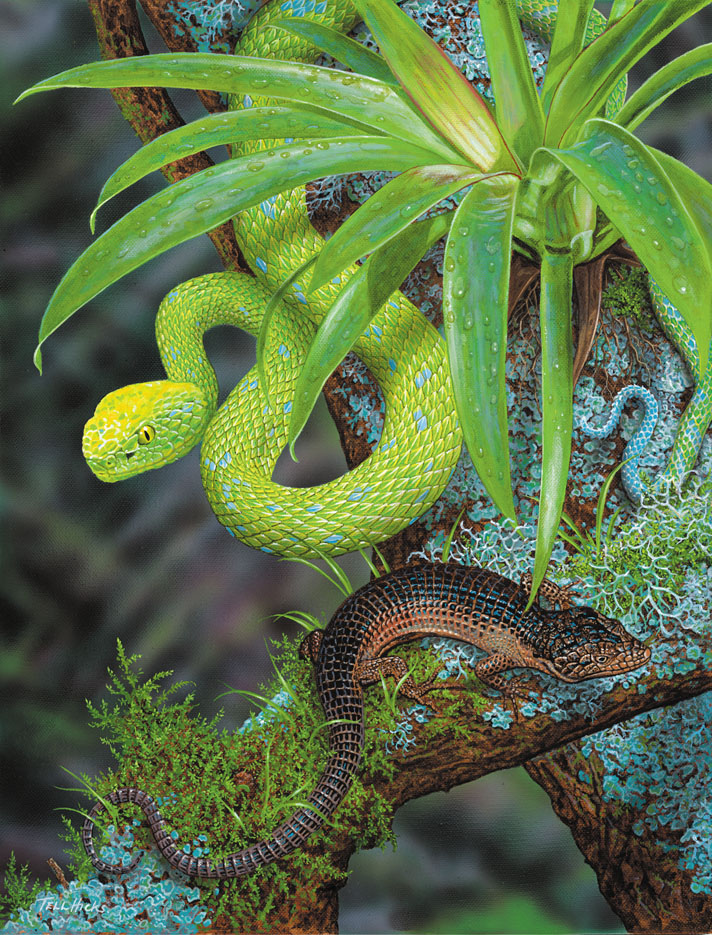
Courtesy Tell Hicks
Rowley’s palm pit viper.
Almost all of my artwork these days is done on commission. I couldn’t survive as a professional artist without the patronage of those who buy my paintings. To have clients who enjoy and value my work, and who have such belief in my ability, is wonderful.
REPTILES: What places do you find particularly helpful in regard to providing you with ideas for your paintings?
Tell Hicks: Australia has always been one of my favorite places to visit and search for reptiles. During the past few years I have really enjoyed my numerous trips to Arizona and the U.S. Southwest, which has become a second home to me.
In 2012, I had the opportunity to visit the Galapagos Islands with a group of fellow herpetologists, and I have been spoiled forever more. I’ve traveled to many countries around the world, but no place has inspired me so much as the Galapagos. I could happily spend the rest of my life painting their unique and captivating wildlife and landscapes.
REPTILES: You must have experienced some humorous or otherwise interesting experiences during your travels.
Tell Hicks: Eileen does not share my love of reptiles but has become accustomed to me searching for and photographing them wherever we travel. I can recall a trip that we made many years ago, when the children were still quite young, when we combined a family holiday to Cyprus with a quest to find Europe’s largest, and potentially most dangerous, viper, the blunt-nosed viper (Macrovipera lebetina). A friend had just returned from the island and given me a map and very detailed directions to where he had seen one.
We set off in our hired car to a very remote corner of the island, and every mile traveled took us further away from civilization. Eileen was increasingly concerned about the venture. She could not drive at the time, and had visions of being stranded without a cell phone and miles from help, should anything happen to me. Nevertheless, she sat beside me, reading the directions on the map, until eventually she informed me that our destination was just beyond the next bend in the road.
To our great surprise, as we navigated the bend, we suddenly came upon a large snake that was in the middle of the road. I slammed on the brakes, jumped out of the vehicle and went off in hot pursuit. It turned out to be a very large whip snake, not the viper that I was after but still a snake that I was very keen to photograph.
Whip snakes are extremely fast moving and, as any herper will agree, you have to move pretty quickly to have any chance of catching one. They are also formidable biters—a bite is almost an inevitable outcome of catching one!
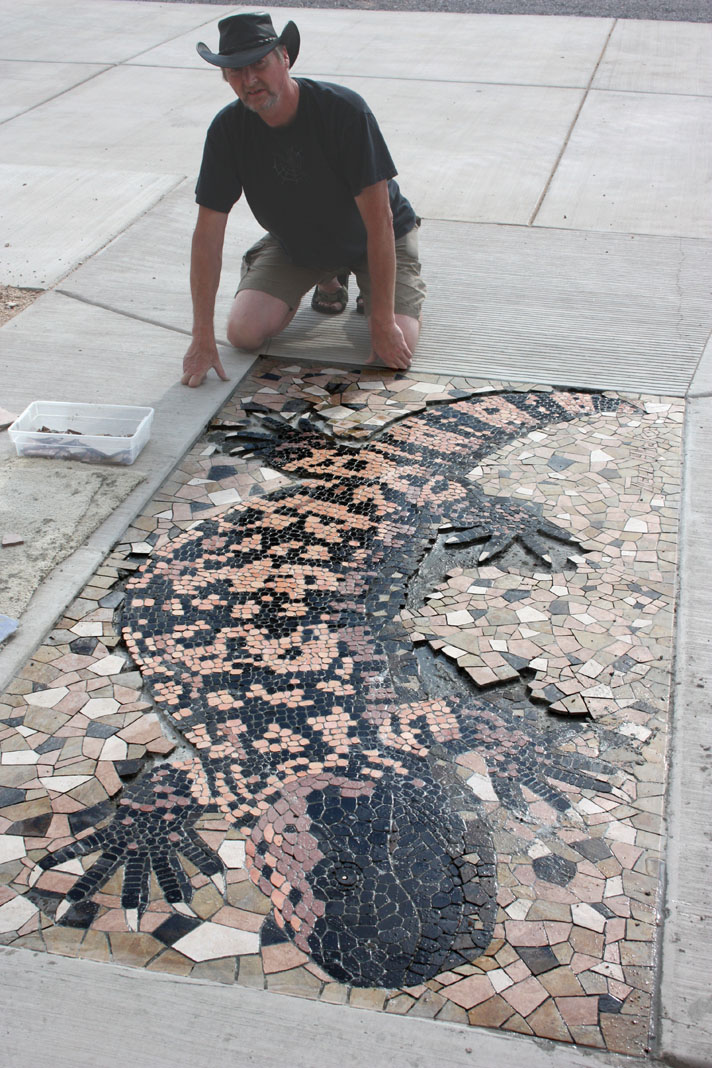
courtesy tell hicks
Tell and the Gila monster mosaic he created for the Chiricahua Desert Museum in Rodeo, N.M.
Determined to cut off the whip snake’s escape, I went skidding across the gravel at the side of the road, and before I could avoid its strike, the snake reared up and sank its teeth into my thigh. I detached the snake from my leg and held it up in triumph.
I could hear what I thought was Eileen and the boys in the car loudly celebrating my success. I thought that they were also amused by my clumsiness, so for comic effect I staggered back toward them with an exaggerated limp.
Unfortunately, in my haste to get out of the car, I had no time to explain to Eileen that the snake that bit me was harmless and not the deadly reptile that she believed it to be. To say that she was not amused upon my limping return to the car would be a gross understatement. She was distraught and so very, very angry with me.
We drove back to the hotel in silence.
REPTILES: You can sometimes be seen at reptile shows working on paintings. What’s that like, working “live?”
Tell Hicks: I’m usually working out in the studio by myself, so it’s quite a change to work in a public place. I’ve never found it to be a problem, though, and enjoy interacting with everyone.
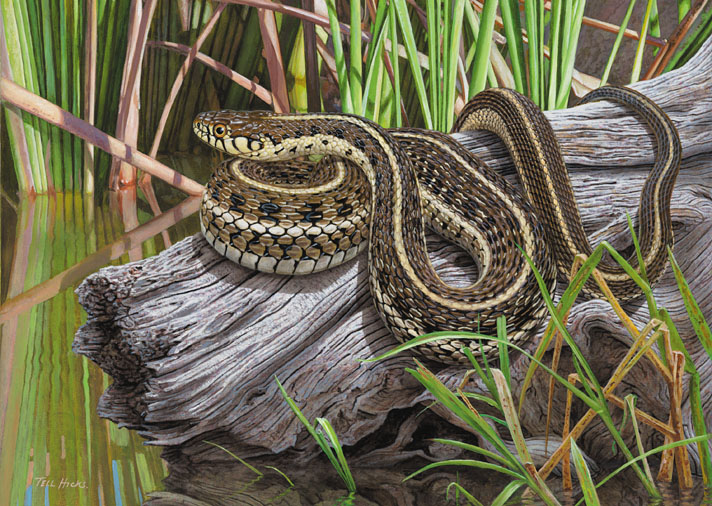
courtesy tell hicks
Mexican garter snake.
Because I build up layers of underpaint in my paintings, they often look very strange or chaotic, and their subjects [may be] almost unrecognisable for the first couple of weeks. For this reason, I prefer to at least reach a stage where the image can be understood before working on it at a show. It’s important, though, that the public can see paint being applied and to see how the canvas develops into a finished image.
Working with fast-drying pigments often allows me to let members of the public make a little contribution to the painting. It’s fun to allow people, especially children, to add a few brush strokes of paint. It’s really entertaining to watch their faces, as I convert their simple daubs of pigment into a wormhole in a log or raindrop on a leaf.
I once allowed a child, whose parents assured me was an”excellent little painter,”to add some paint, and to everyone’s shock and horror the child took a brush full of white paint and spread it right across the canvas. Luckily, and to the great relief of the parents, most of the painting was dry enough for me to simply wipe the offending brush stroke away.
REPTILES: What advice would you have for aspiring artists who would relish following in your footsteps?
Tell Hicks: I’d give the same advice that I’d give to anyone with a passion for anything. Don’t let someone else steal your dreams! Make the effort, work hard and be disciplined with your time and efforts. It’s not an easy profession to break into, but if you are doing something that you like doing, even if you eventually choose a different career path, you’ll have enjoyed yourself.
REPTILES: Do you have a website where people can go to learn more, and perhaps even purchase some of your artwork?
I usually post recent projects and trips on Facebook, but there are several websites where people can see and purchase prints, t-shirts and caps. For customers in the USA: reptileshirts.com for prints, t-shirts and caps, or to commission a painting. For customers in Europe: chimaira.de (Germany) or tellhicks.com (UK).
Russ Case is the editor of REPTILES magazine.

